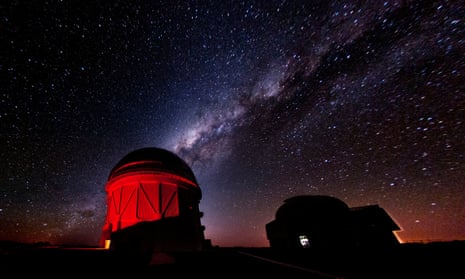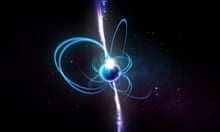One of the most precise surveys of the structure of the universe has suggested it is “less clumpy” than expected, in findings that could indicate the existence of mysterious forces at work.
The observations by the Dark Energy Survey and the South Pole Telescope chart the distribution of matter with the aim of understanding the competing forces that shaped the evolution of the universe and govern its ultimate fate. The extraordinarily detailed analysis adds to a body of evidence that suggests there may be a crucial component missing from the so-called standard model of physics.
“It seems like there is slightly less [clumpiness] in the current universe than we would predict assuming our standard cosmological model anchored to the early universe,” said Eric Baxter, an astrophysicist at the University of Hawaii and co-author of the study.
The results did not pass the statistical threshold that scientists consider to be ironclad enough to claim a discovery, but they do come after similar findings from previous surveys that hint a crack could be opening up between theoretical predictions and what is actually going on in the universe.
“If the finding stands up it’s very exciting,” said Dr Chihway Chang, an astrophysicist at the University of Chicago and a lead author. “The whole point of physics is to test models and break them. The best scenario is it helps us understand more about the nature of dark matter and dark energy.”
Since the big bang 13bn years ago, the universe has been expanding, but matter has also been cooling and clumping as gravity pulls denser areas together, creating a cosmic web of galaxy clusters and filaments. As scientists have worked to understand this cosmic tug of war, a bizarre picture has emerged in which only about 5% of the contents of the universe are accounted for by ordinary matter. Approximately 25% is so-called dark matter, invisible mass that is contributing gravitationally, but otherwise invisible. The remaining 70% is dark energy – a mysterious phenomenon that is said to explain why the expansion of the universe is accelerating rather than being slowed down by gravity.
The latest work uses data from the Dark Energy Survey, which surveyed the sky over six years from a mountaintop in Chile, and the South Pole Telescope, which looks for the faint traces of radiation travelling across the sky from the first few moments of the universe. In both cases, the analysis uses a phenomenon called gravitational lensing, whereby light is slightly bent as it passes massive objects, such as galaxies and clumps of dark matter, allowing scientists to infer the distribution of matter in the universe.
Separately, the scientists can infer the structure of the very early universe from heat left over from the big bang and use computational models to “fast forward” and see whether the models line up with observations.
The analysis indicates that matter is not as “clumpy” as expected. According to Prof Carlos Frenk, a cosmologist at the University of Durham who was not involved in the research, there are three likely explanations. First, it could be a result of noise in the data or a systematic error in the telescope. It is also possible that, rather than a major rewrite of cosmological theory, a poorly understood astronomical phenomenon could explain the results. “For example, supermassive black holes at the centres of galaxies can produce huge jets of radiation that can, in principle, push the matter around and smooth it out a bit,” he said.
The third, most exciting option, is that the discrepancy is explained by entirely new physics, such as the existence of new kinds of neutrinos, exotic behaviour of the dark energy or unconventional forms of dark matter. “From the three possibilities, I hope it is the last one, I fear it is the second one but I suspect it is the first one,” said Frenk.
The findings are published in the journal Physical Review D.










